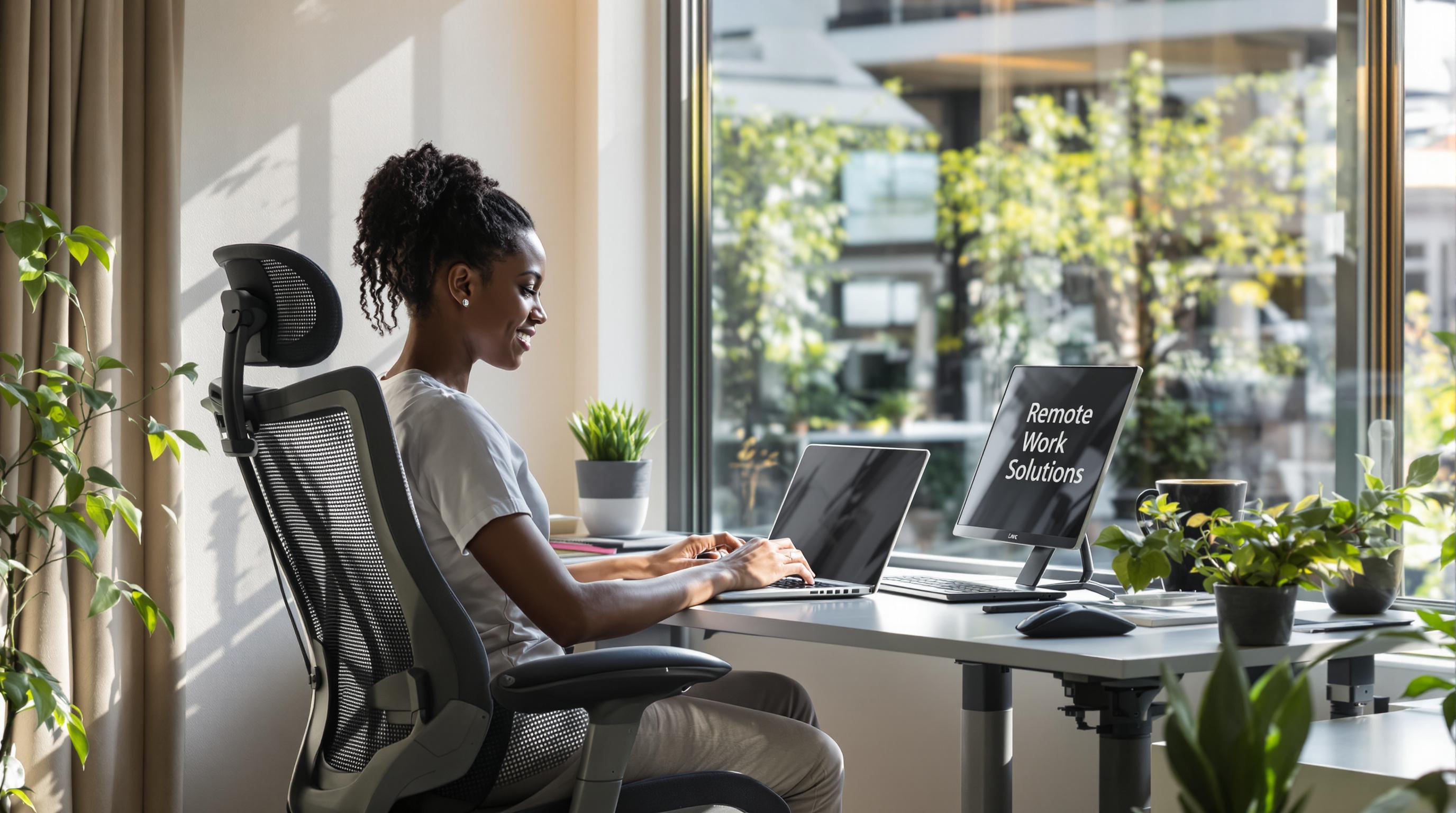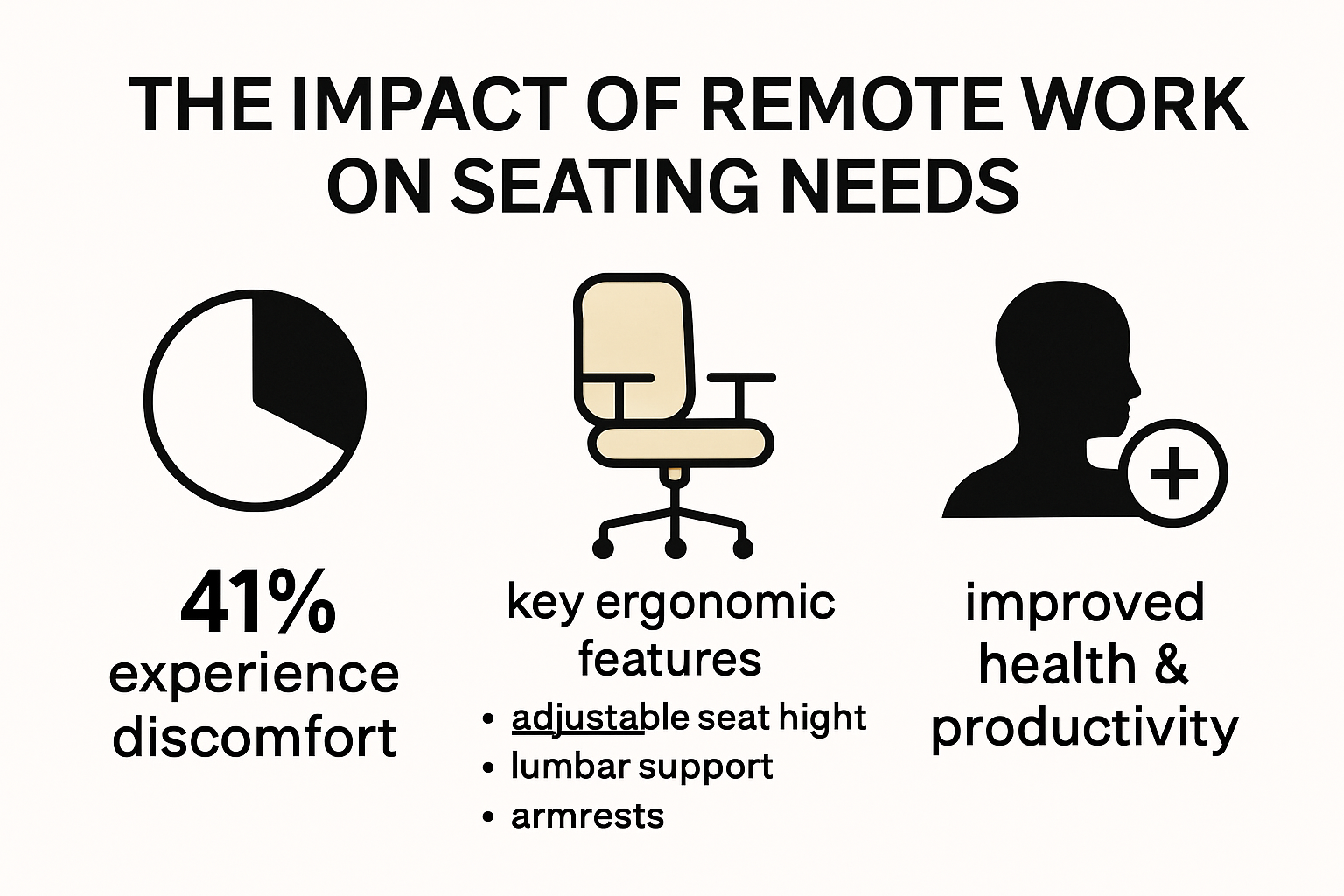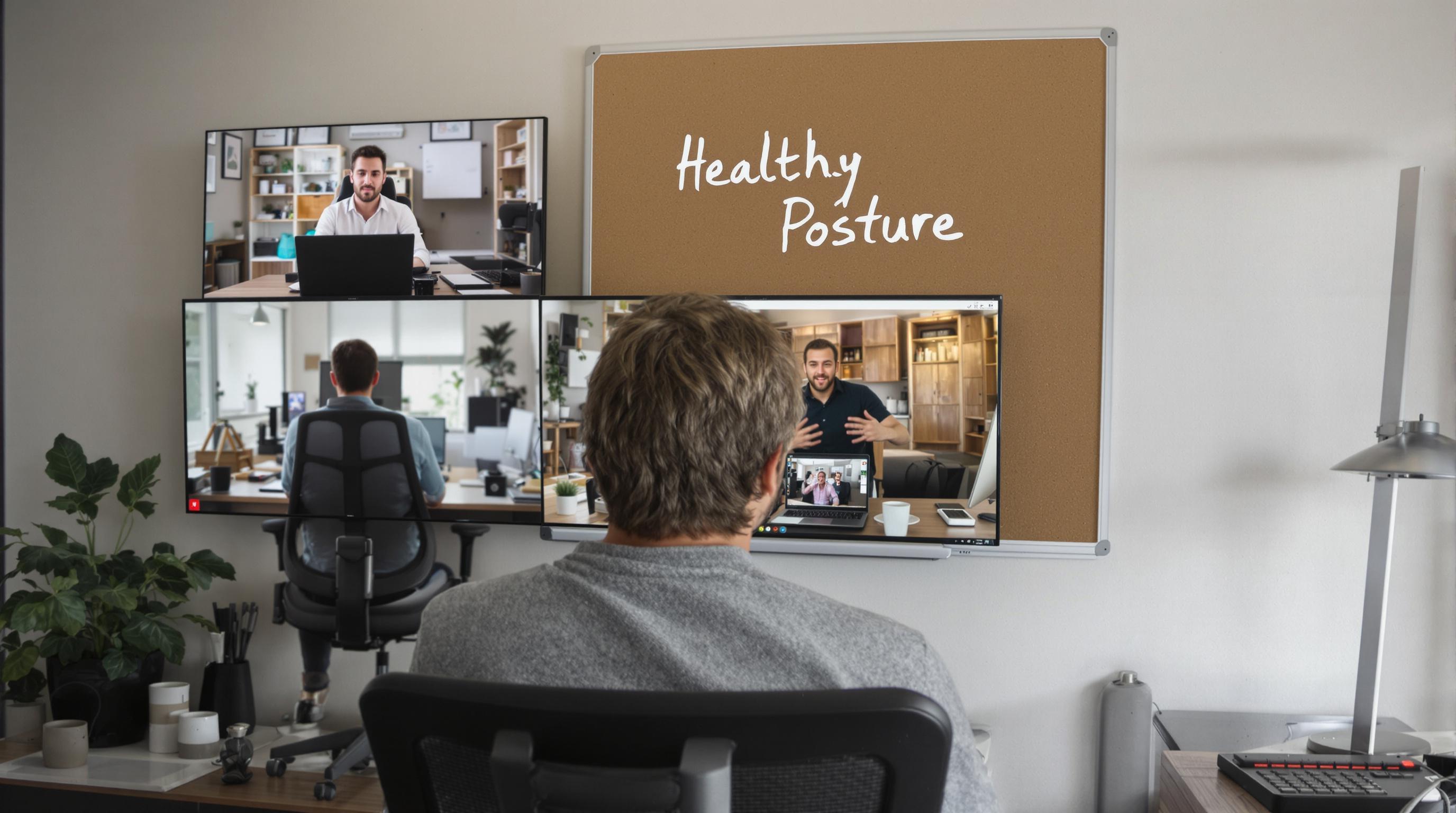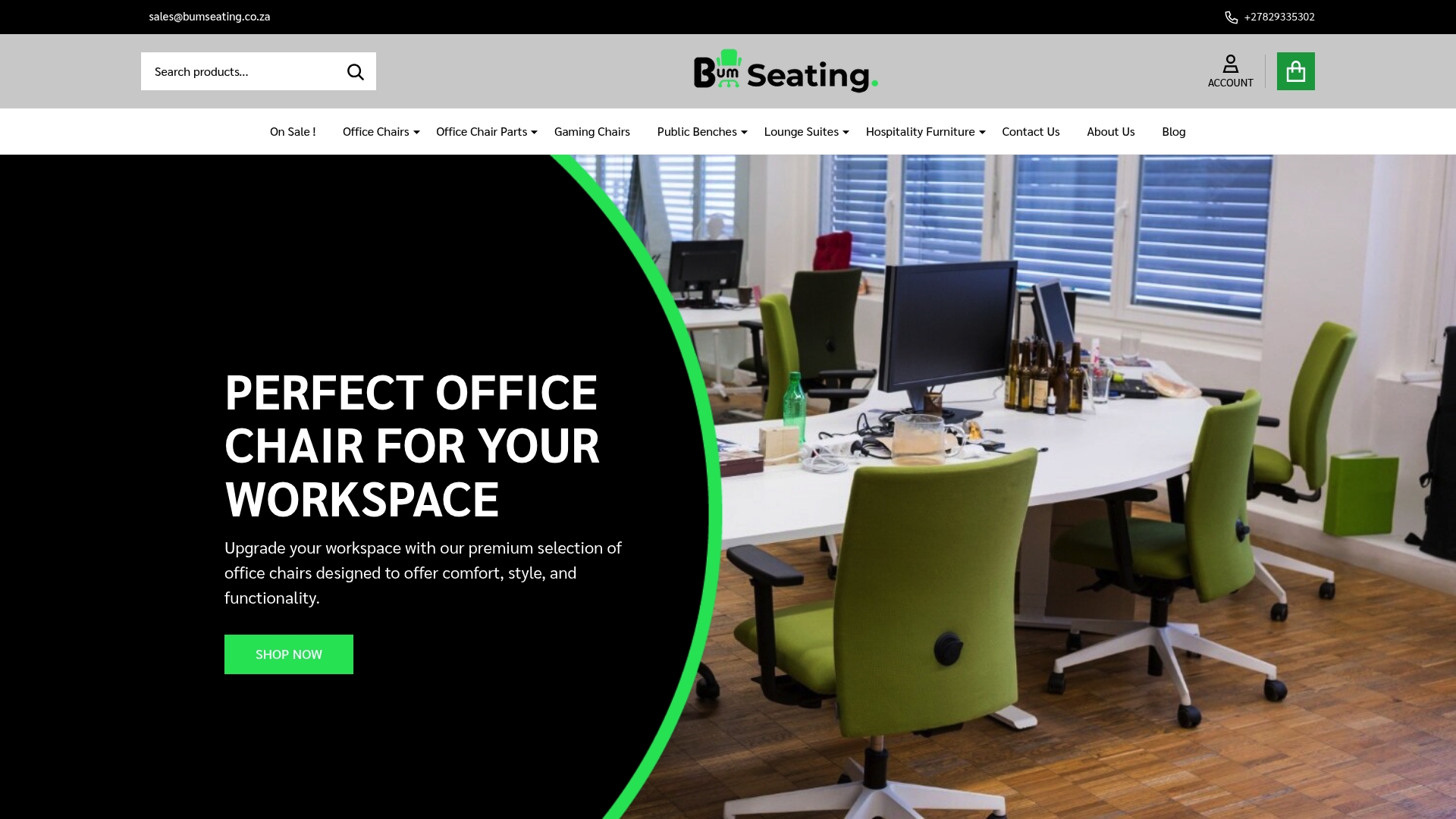Remote Work and Seating: Smart Solutions for 2025 Offices
21st Jul 2025
Remote Work and Seating: Smart Solutions for 2025 Offices

Remote work has exploded in South Africa and plenty of people are realising how much time they spend sitting behind a desk at home. Here’s something unexpected. More than 86 percent of remote workers struggle with physical discomfort because of poor seating at home. Yet upgrading your chair is not just about adding comfort or a fancy design. It’s actually a key move for lasting health and productivity in any remote setup.
Table of Contents
- Understanding Remote Work And Seating Needs
- Best Seating Options For Remote Work Success
- Ergonomic Tips For South African Remote Offices
- Choosing Furniture For Hybrid And Flexible Workspaces
Quick Summary
| Takeaway | Explanation |
|---|---|
| Ergonomic seating is essential for remote work success | Over 86% of remote workers experience physical discomfort due to inadequate seating, emphasizing the need for thoughtfully designed seating solutions that support health and productivity. |
| Advanced technologies improve seating effectiveness | Features like adaptive support, biomechanical tracking, and customizable configurations in seating can significantly reduce the risk of musculoskeletal disorders and enhance comfort. |
| Local adaptability for South African work environments is crucial | Diverse home office conditions and climate variations in South Africa necessitate ergonomic solutions that cater to varied body types and working conditions, ensuring comfort across different settings. |
| Hybrid workspaces require flexible furniture solutions | With 72% of organizations implementing hybrid models, furniture must be modular, portable, and designed for quick reconfiguration to support various work scenarios and enhance productivity. |
| Investing in ergonomic furniture is a strategic decision | Prioritizing high-quality, adjustable seating and adaptable work furniture is not merely an expense; it is a vital investment in employee health, satisfaction, and overall performance. |
Understanding Remote Work and Seating Needs
The transformation of workplace dynamics has fundamentally reshaped how professionals approach their working environments. Remote work and seating solutions have become critical considerations for businesses seeking to optimize employee comfort and productivity. Bum Seating recognizes that the future of work demands innovative approaches to workplace ergonomics.

The Ergonomic Evolution of Remote Workspaces
Remote work has dramatically shifted traditional office paradigms, creating unique challenges for employee comfort and health. Research from the International Ergonomics Association reveals that 86% of remote workers experience physical discomfort related to inadequate seating arrangements. This statistic underscores the critical need for thoughtful seating solutions that support human body mechanics in non-traditional work environments.
The modern professional spends an average of 6-8 hours daily in seated positions, with many working from home offices, shared spaces, or flexible work environments. This significant time investment demands seating solutions that go beyond basic functionality. Ergonomic considerations now include adaptability, support, and the ability to transition between different working postures seamlessly.
Technology and Seating Convergence
Advanced seating technologies are revolutionizing how we approach workplace comfort. A study by the Occupational Health and Safety Administration highlights that proper seating can reduce musculoskeletal disorders by up to 40%. Smart seating solutions now incorporate advanced features like:
- Adaptive Support mechanisms that automatically adjust to individual body movements
- Biomechanical Tracking capabilities that monitor posture and provide real-time ergonomic recommendations
- Customizable Configurations allowing seamless transitions between work modes
Bum Seating understands that smart office seating solutions represent more than just furniture. They are integral components of a holistic approach to employee well-being and productivity.
The future of remote work demands intelligent, responsive seating that supports the dynamic nature of modern professional environments. As companies continue to embrace flexible work models, investing in high-quality, ergonomically designed seating becomes not just a luxury, but a fundamental requirement for maintaining employee health and performance.
Businesses and individuals must recognize that seating is no longer a static element of workspace design. It is a dynamic, interactive component that directly impacts physical health, mental well-being, and overall work effectiveness. By prioritizing thoughtful seating solutions, organizations can create supportive environments that empower employees to perform at their best, regardless of their physical location.
Best Seating Options for Remote Work Success
Navigating the complex landscape of remote work seating requires strategic selection and understanding of individual ergonomic needs. Bum Seating recognizes that selecting the right chair is not just about comfort, but about creating an environment that supports productivity, health, and professional performance.
Ergonomic Chair Fundamentals
The cornerstone of effective remote work seating lies in comprehensive ergonomic design. Research from the American Chiropractic Association indicates that proper chair selection can reduce workplace-related musculoskeletal disorders by up to 55%. Key features that define exceptional remote work seating include:
- Adjustable Lumbar Support that maintains natural spine curvature
- Height-Adjustable Mechanisms accommodating different body types
- Dynamic Seat Mechanisms allowing movement and postural variation

Modern professionals require chairs that adapt to their unique physical characteristics and work styles. This means moving beyond one-size-fits-all solutions towards personalized seating experiences that promote long-term physical well-being.
Advanced Seating Technologies
A comprehensive study by Cornell University’s Ergonomics Research Laboratory revealed that intelligent seating technologies can improve worker comfort and productivity by approximately 37%. Contemporary remote work chairs now integrate sophisticated features such as:
- Pressure-sensitive materials that redistribute body weight
- Integrated sensors tracking posture and recommending movement
- Breathable fabrics that regulate temperature and moisture
Bum Seating understands that modern office chair innovations represent more than aesthetic upgrades. They are sophisticated tools designed to enhance human performance and well-being.
Specialized Seating Configurations
Remote work environments demand flexibility. Different work activities require nuanced seating approaches. A graphic designer might need a chair with different specifications compared to a software developer or a customer service representative. Understanding these specialized needs becomes crucial in creating optimal workspace environments.
Executive chairs with high backs provide excellent support for prolonged work sessions, while task chairs offer more mobility for dynamic work environments. Gaming chairs have also emerged as versatile options, providing robust support and comfort for extended periods of seated work.
Investing in high-quality seating is not an expense but a strategic decision that directly impacts employee health, productivity, and job satisfaction. By prioritizing ergonomic design and individual needs, organizations and remote workers can create workspaces that support peak performance and long-term well-being.
The future of remote work seating is adaptive, intelligent, and deeply personalized. As technology continues to evolve, so too will our understanding of how seating can transform work experiences, making comfort and efficiency seamless companions in the professional journey.
Ergonomic Tips for South African Remote Offices
The South African remote work landscape presents unique challenges that demand tailored ergonomic solutions. Bum Seating recognizes that local professionals require specialized approaches to creating comfortable and productive home office environments that account for diverse working conditions and individual needs.
Local Ergonomic Considerations
Research from the South African Society of Physiotherapy highlights that 67% of remote workers in South Africa experience significant musculoskeletal discomfort due to inadequate workspace setups. This statistic underscores the critical importance of implementing strategic ergonomic interventions that address local working conditions.
South African remote workers often contend with varied home environments, from compact urban apartments to rural home offices. These diverse settings require flexible seating solutions that can adapt to limited spaces while maintaining optimal ergonomic support. Compact chairs with multiple adjustment points become essential, allowing professionals to maximize comfort in potentially restricted working areas.
Climate-Adaptive Seating Strategies
A study by the University of Pretoria’s Ergonomics Research Unit revealed that South Africa’s diverse climate zones significantly impact workplace comfort. Coastal regions with high humidity and inland areas with extreme temperatures demand seating solutions that offer:
- Breathable Materials that manage heat and moisture
- Adaptable Support mechanisms for different body types
- Temperature-Regulating Fabrics that provide comfort across varying environmental conditions
Bum Seating understands that ergonomic chair design must go beyond standard international recommendations to address local environmental challenges.
Cultural and Workspace Diversity
South African remote work environments reflect the country’s rich cultural diversity. Professionals from different backgrounds require seating solutions that accommodate varied body types, working styles, and home office configurations. This means developing chairs that offer:
- Extensive height and width adjustments
- Multiple lumbar support configurations
- Lightweight designs for easy repositioning
- Durability to withstand diverse home environment conditions
The future of remote work in South Africa demands a nuanced approach to seating that recognizes individual needs while providing universal ergonomic benefits. By investing in intelligent, adaptable seating solutions, professionals can create workspaces that support health, productivity, and personal comfort.
Ultimately, ergonomic excellence is not about a one-size-fits-all approach, but about creating personalized solutions that empower South African professionals to work efficiently and comfortably, regardless of their physical workspace constraints. As remote work continues to evolve, so too must our understanding of how intelligent seating can transform professional experiences across diverse working environments.
Choosing Furniture for Hybrid and Flexible Workspaces
The evolution of workplace dynamics demands innovative furniture solutions that transcend traditional office boundaries. Bum Seating recognizes that hybrid and flexible workspaces require strategic furniture selections that adapt to changing professional landscapes and diverse work environments.
Adaptive Furniture Design Principles
Research from the Global Workplace Analytics Institute reveals that 72% of organizations are now implementing hybrid work models, necessitating furniture solutions that support seamless transitions between home, office, and remote environments. This paradigm shift requires furniture that is not just functional, but dynamically responsive to varied work scenarios.
Key considerations for hybrid workspace furniture include modularity, lightweight design, and multi-functional capabilities. Professionals need chairs and workstations that can quickly transform between collaborative team settings and individual focus zones. Furniture must become an active participant in workplace productivity, rather than a passive background element.
Technology Integration and Mobility
A comprehensive study by the International Workplace Design Association highlights that modern furniture must incorporate technological adaptability. Smart furniture solutions now feature:
- Integrated Charging Stations for multiple device connectivity
- Wireless Connectivity enabling seamless technology integration
- Compact Folding Mechanisms for easy transportation and storage
Bum Seating understands that modern office furniture solutions represent more than static workplace elements. They are dynamic tools that support professional flexibility and technological innovation.
Ergonomic Considerations for Flexible Environments
Hybrid workspaces demand furniture that provides consistent ergonomic support across multiple environments. This means developing chairs and workstations that can be quickly adjusted to accommodate different body types, work styles, and physical settings. Lightweight, portable chairs with comprehensive adjustment mechanisms become critical in supporting professional mobility.
Materials selection plays a crucial role in creating versatile furniture. High-performance fabrics that resist wear, manage temperature, and provide comfort across diverse environments are essential. Quick-clean surfaces, antimicrobial treatments, and durability become paramount considerations for furniture designed to move between multiple workspace configurations.
The future of workplace furniture lies in its ability to be simultaneously flexible, comfortable, and technologically integrated. Organizations must view furniture not as a static investment, but as a dynamic ecosystem that supports evolving work methodologies.
Ultimately, choosing furniture for hybrid workspaces is about creating environments that empower professionals to work efficiently, comfortably, and adaptively. By prioritizing intelligent design, technological integration, and ergonomic excellence, businesses can develop workspace solutions that transform how work happens in an increasingly dynamic professional world.
To help readers quickly compare different seating options described in the article, here’s a table summarising their key features and best-use scenarios:
| Seating Type | Key Features | Best Use Case |
|---|---|---|
| Executive Chair | High back, strong lumbar support | Prolonged work sessions |
| Task Chair | Mobility, adjustable, dynamic seat mechanisms | Dynamic/multiple-task work |
| Gaming Chair | Robust support, comfort for extended sits | Extended focused sessions |
| Compact Chair | Small footprint, multiple adjustment points | Limited home office spaces |
The following table organises the major ergonomic and technological features that modern remote work chairs can offer, as described throughout the article:
| Feature | Description | Benefits |
|---|---|---|
| Adjustable Lumbar Support | Maintains natural spine curvature | Reduces back pain |
| Height Adjustability | Fits different body types | Promotes upright posture |
| Dynamic Seat Mechanisms | Enables movement and postural variation | Prevents fatigue |
| Pressure-sensitive Material | Redistributes body weight | Enhances comfort |
| Breathable Fabrics | Regulates temperature and moisture | Suitable for SA’s climate |
| Integrated Sensors | Tracks posture, gives reminders | Improves health outcomes |
Frequently Asked Questions
What are the benefits of ergonomic seating for remote work?
Ergonomic seating helps reduce physical discomfort, enhances productivity, and lowers the risk of musculoskeletal disorders. It is essential for maintaining health during long hours of sitting.
How can I choose the right chair for my home office?
Look for adjustable lumbar support, height adjustability, and dynamic seat mechanisms. Consider your body type and the type of work you do to find a chair that suits your individual needs.
What are some common features of advanced seating technologies?
Advanced seating technologies include adaptive support that adjusts to body movements, biomechanical tracking for posture monitoring, and customizable configurations for different working modes.
Why is climate adaptability important for seating in South Africa?
South Africa has diverse climate zones, which affect comfort. Climate-adaptive seating features breathable materials and temperature-regulating fabrics to ensure comfort in various environmental conditions.
Ready to Leave Discomfort Behind? Choose Smarter Seating for Remote Work
Most South Africans working from home are still suffering from daily aches and pains, just like highlighted in our article about smart office seating solutions for 2025. You read the facts. Over 86 percent of remote workers live with neck or back pain due to poor seating. This is more than a nuisance—ongoing discomfort drains productivity, impacts well-being, and even puts your long-term health at risk. You deserve a solution that matches the demands of flexible and hybrid work.

Why let outdated or inadequate chairs hold you back any longer? Experience the difference of ergonomic, modern seating designed to boost comfort and health in South African conditions. Explore our extensive catalogue of ergonomic office chairs and seating options, each crafted to support the smarter workspace you are building. Give your home office a real upgrade today. Visit Bum Seating and make comfort your priority—your next productive, pain-free workday is just a click away.
Recommended
- Reconfigurable Office Seating: Smart Solutions for 2025 - Bum Seating
- Tasks Chairs vs Conference Chairs: Smart Choices for 2025 - Bum Seating
- Top Statement Seating Ideas for Modern Spaces 2025 - Bum Seating
- Active Seating Solutions for Modern Offices and Homes 2025 - Bum Seating
- Top Remote Consulting Tips for IT Professionals 2025
